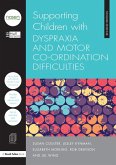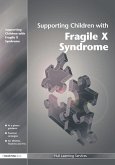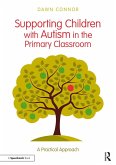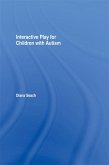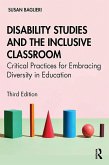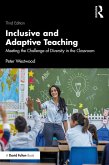Hull City Council
Supporting Children with Behaviour Issues in the Classroom (eBook, PDF)
26,95 €
26,95 €
inkl. MwSt.
Sofort per Download lieferbar

13 °P sammeln
26,95 €
Als Download kaufen

26,95 €
inkl. MwSt.
Sofort per Download lieferbar

13 °P sammeln
Jetzt verschenken
Alle Infos zum eBook verschenken
26,95 €
inkl. MwSt.
Sofort per Download lieferbar
Alle Infos zum eBook verschenken

13 °P sammeln
Hull City Council
Supporting Children with Behaviour Issues in the Classroom (eBook, PDF)
- Format: PDF
- Merkliste
- Auf die Merkliste
- Bewerten Bewerten
- Teilen
- Produkt teilen
- Produkterinnerung
- Produkterinnerung

Bitte loggen Sie sich zunächst in Ihr Kundenkonto ein oder registrieren Sie sich bei
bücher.de, um das eBook-Abo tolino select nutzen zu können.
Hier können Sie sich einloggen
Hier können Sie sich einloggen
Sie sind bereits eingeloggt. Klicken Sie auf 2. tolino select Abo, um fortzufahren.

Bitte loggen Sie sich zunächst in Ihr Kundenkonto ein oder registrieren Sie sich bei bücher.de, um das eBook-Abo tolino select nutzen zu können.
This completely revised edition is an easy to use resource for teachers, TAs and SENCOs concerned about behavioural issues in the classroom. It will support school staff in their approach to a range of behavioural issues, through a range of tried-and-tested strategies
- Geräte: PC
- mit Kopierschutz
- eBook Hilfe
- Größe: 0.9MB
Andere Kunden interessierten sich auch für
![Supporting Children with Autistic Spectrum Disorders (eBook, PDF) Supporting Children with Autistic Spectrum Disorders (eBook, PDF)]() A. P. H PetersSupporting Children with Autistic Spectrum Disorders (eBook, PDF)27,95 €
A. P. H PetersSupporting Children with Autistic Spectrum Disorders (eBook, PDF)27,95 €![Supporting Children with Dyspraxia and Motor Co-ordination Difficulties (eBook, PDF) Supporting Children with Dyspraxia and Motor Co-ordination Difficulties (eBook, PDF)]() Hull City CouncilSupporting Children with Dyspraxia and Motor Co-ordination Difficulties (eBook, PDF)28,95 €
Hull City CouncilSupporting Children with Dyspraxia and Motor Co-ordination Difficulties (eBook, PDF)28,95 €![Supporting Children with Fragile X Syndrome (eBook, PDF) Supporting Children with Fragile X Syndrome (eBook, PDF)]() Hull Learning ServicesSupporting Children with Fragile X Syndrome (eBook, PDF)27,95 €
Hull Learning ServicesSupporting Children with Fragile X Syndrome (eBook, PDF)27,95 €![Supporting Children with Autism in the Primary Classroom (eBook, PDF) Supporting Children with Autism in the Primary Classroom (eBook, PDF)]() Dawn ConnorSupporting Children with Autism in the Primary Classroom (eBook, PDF)37,95 €
Dawn ConnorSupporting Children with Autism in the Primary Classroom (eBook, PDF)37,95 €![Interactive Play for Children with Autism (eBook, PDF) Interactive Play for Children with Autism (eBook, PDF)]() Diana SeachInteractive Play for Children with Autism (eBook, PDF)39,95 €
Diana SeachInteractive Play for Children with Autism (eBook, PDF)39,95 €![Disability Studies and the Inclusive Classroom (eBook, PDF) Disability Studies and the Inclusive Classroom (eBook, PDF)]() Susan BaglieriDisability Studies and the Inclusive Classroom (eBook, PDF)52,95 €
Susan BaglieriDisability Studies and the Inclusive Classroom (eBook, PDF)52,95 €![Inclusive and Adaptive Teaching (eBook, PDF) Inclusive and Adaptive Teaching (eBook, PDF)]() Peter WestwoodInclusive and Adaptive Teaching (eBook, PDF)28,95 €
Peter WestwoodInclusive and Adaptive Teaching (eBook, PDF)28,95 €-
-
-
This completely revised edition is an easy to use resource for teachers, TAs and SENCOs concerned about behavioural issues in the classroom. It will support school staff in their approach to a range of behavioural issues, through a range of tried-and-tested strategies
Dieser Download kann aus rechtlichen Gründen nur mit Rechnungsadresse in A, B, BG, CY, CZ, D, DK, EW, E, FIN, F, GR, HR, H, IRL, I, LT, L, LR, M, NL, PL, P, R, S, SLO, SK ausgeliefert werden.
Produktdetails
- Produktdetails
- Verlag: Taylor & Francis eBooks
- Seitenzahl: 134
- Erscheinungstermin: 25. Juli 2016
- Englisch
- ISBN-13: 9781317202004
- Artikelnr.: 45474752
- Verlag: Taylor & Francis eBooks
- Seitenzahl: 134
- Erscheinungstermin: 25. Juli 2016
- Englisch
- ISBN-13: 9781317202004
- Artikelnr.: 45474752
- Herstellerkennzeichnung Die Herstellerinformationen sind derzeit nicht verfügbar.
Sarah Carr - Well-being Officer, Eastfied Primary School, Hull, UK.
Susan Coulter - former Special School Headteacher, UK.
Elizabeth Morling - Series Editor, SEN Consultant and former Head of the Education Service for Physical Disability, Hull City Council, UK
Rebecca Smith - Well-being Officer, Eastfied Primary School, Hull, UK.
Susan Coulter - former Special School Headteacher, UK.
Elizabeth Morling - Series Editor, SEN Consultant and former Head of the Education Service for Physical Disability, Hull City Council, UK
Rebecca Smith - Well-being Officer, Eastfied Primary School, Hull, UK.
Foreword Introduction Section 1: Legislation and guidance 1. Legislation 2.
Discipline in school - teachers powers and the use of reasonable force
Section 2: Whole school approaches 3. Whole school thinking 4. Whole school
issues 5. Developing a behaviour policy 6. Restorative Practices Section 3:
Putting policies into practise to create a positive learning environment
7. Providing a positive learning environment: Early Years 8. Providing an
effective learning environment: Primary and Secondary Provision 9. Lesson
activity and delivery 10. Communication 11. Creating a positive environment
12. Play/breaktimes and lunchtimes 13. Gender difference Section 4: Support
staff 14. Support staff: working in the classroom 15. Support staff:
guidelines for working with pupils Section 5: Pupils and parents 16. The
voice of the pupil 17. Developing self-esteem 18. Developing peer
relationships 19. Ways to develop good relationships with pupils and staff
20. Anti-bullying 21. Working with parents Section 6: Approaches and
Interventions for those pupils who require an individual response 20.
Observing the pupil 21. Behaviour modification 22. Personal Support Plan
(PSP) 23. Coping with a violent incident Section 7: Underlying factors 24.
Supporting pupil's mental health 25. Developing resilience 26. Depression
27. Conduct disorder 28. Self- harm 29. Eating disorders 30. Attachment
disorder 31. Attention deficit hyperactivity disorder (ADHD) 34. Attention
seeking behaviour 35. Autism 36. Section 8: Continuing Professional
Development 37. Planning for Continuing Professional Development 38.
Evaluating and following up on Continuing Professional Development
References and useful contacts Appendices 1. Elements of a Positive
Behaviour Policy 2. Behaviour policy: Primary School 3. Behaviour policy:
Secondary School 4. Guidance Policy for Enhancing Community Relationships
and Learning for a School with Restorative Practice (Behaviour Policy) 5. A
sample Pupil Incident form 6. One schools staged framework to manage
behaviour 7. Examples of rewards
Discipline in school - teachers powers and the use of reasonable force
Section 2: Whole school approaches 3. Whole school thinking 4. Whole school
issues 5. Developing a behaviour policy 6. Restorative Practices Section 3:
Putting policies into practise to create a positive learning environment
7. Providing a positive learning environment: Early Years 8. Providing an
effective learning environment: Primary and Secondary Provision 9. Lesson
activity and delivery 10. Communication 11. Creating a positive environment
12. Play/breaktimes and lunchtimes 13. Gender difference Section 4: Support
staff 14. Support staff: working in the classroom 15. Support staff:
guidelines for working with pupils Section 5: Pupils and parents 16. The
voice of the pupil 17. Developing self-esteem 18. Developing peer
relationships 19. Ways to develop good relationships with pupils and staff
20. Anti-bullying 21. Working with parents Section 6: Approaches and
Interventions for those pupils who require an individual response 20.
Observing the pupil 21. Behaviour modification 22. Personal Support Plan
(PSP) 23. Coping with a violent incident Section 7: Underlying factors 24.
Supporting pupil's mental health 25. Developing resilience 26. Depression
27. Conduct disorder 28. Self- harm 29. Eating disorders 30. Attachment
disorder 31. Attention deficit hyperactivity disorder (ADHD) 34. Attention
seeking behaviour 35. Autism 36. Section 8: Continuing Professional
Development 37. Planning for Continuing Professional Development 38.
Evaluating and following up on Continuing Professional Development
References and useful contacts Appendices 1. Elements of a Positive
Behaviour Policy 2. Behaviour policy: Primary School 3. Behaviour policy:
Secondary School 4. Guidance Policy for Enhancing Community Relationships
and Learning for a School with Restorative Practice (Behaviour Policy) 5. A
sample Pupil Incident form 6. One schools staged framework to manage
behaviour 7. Examples of rewards
Foreword Introduction Section 1: Legislation and guidance 1. Legislation 2.
Discipline in school - teachers powers and the use of reasonable force
Section 2: Whole school approaches 3. Whole school thinking 4. Whole school
issues 5. Developing a behaviour policy 6. Restorative Practices Section 3:
Putting policies into practise to create a positive learning environment
7. Providing a positive learning environment: Early Years 8. Providing an
effective learning environment: Primary and Secondary Provision 9. Lesson
activity and delivery 10. Communication 11. Creating a positive environment
12. Play/breaktimes and lunchtimes 13. Gender difference Section 4: Support
staff 14. Support staff: working in the classroom 15. Support staff:
guidelines for working with pupils Section 5: Pupils and parents 16. The
voice of the pupil 17. Developing self-esteem 18. Developing peer
relationships 19. Ways to develop good relationships with pupils and staff
20. Anti-bullying 21. Working with parents Section 6: Approaches and
Interventions for those pupils who require an individual response 20.
Observing the pupil 21. Behaviour modification 22. Personal Support Plan
(PSP) 23. Coping with a violent incident Section 7: Underlying factors 24.
Supporting pupil's mental health 25. Developing resilience 26. Depression
27. Conduct disorder 28. Self- harm 29. Eating disorders 30. Attachment
disorder 31. Attention deficit hyperactivity disorder (ADHD) 34. Attention
seeking behaviour 35. Autism 36. Section 8: Continuing Professional
Development 37. Planning for Continuing Professional Development 38.
Evaluating and following up on Continuing Professional Development
References and useful contacts Appendices 1. Elements of a Positive
Behaviour Policy 2. Behaviour policy: Primary School 3. Behaviour policy:
Secondary School 4. Guidance Policy for Enhancing Community Relationships
and Learning for a School with Restorative Practice (Behaviour Policy) 5. A
sample Pupil Incident form 6. One schools staged framework to manage
behaviour 7. Examples of rewards
Discipline in school - teachers powers and the use of reasonable force
Section 2: Whole school approaches 3. Whole school thinking 4. Whole school
issues 5. Developing a behaviour policy 6. Restorative Practices Section 3:
Putting policies into practise to create a positive learning environment
7. Providing a positive learning environment: Early Years 8. Providing an
effective learning environment: Primary and Secondary Provision 9. Lesson
activity and delivery 10. Communication 11. Creating a positive environment
12. Play/breaktimes and lunchtimes 13. Gender difference Section 4: Support
staff 14. Support staff: working in the classroom 15. Support staff:
guidelines for working with pupils Section 5: Pupils and parents 16. The
voice of the pupil 17. Developing self-esteem 18. Developing peer
relationships 19. Ways to develop good relationships with pupils and staff
20. Anti-bullying 21. Working with parents Section 6: Approaches and
Interventions for those pupils who require an individual response 20.
Observing the pupil 21. Behaviour modification 22. Personal Support Plan
(PSP) 23. Coping with a violent incident Section 7: Underlying factors 24.
Supporting pupil's mental health 25. Developing resilience 26. Depression
27. Conduct disorder 28. Self- harm 29. Eating disorders 30. Attachment
disorder 31. Attention deficit hyperactivity disorder (ADHD) 34. Attention
seeking behaviour 35. Autism 36. Section 8: Continuing Professional
Development 37. Planning for Continuing Professional Development 38.
Evaluating and following up on Continuing Professional Development
References and useful contacts Appendices 1. Elements of a Positive
Behaviour Policy 2. Behaviour policy: Primary School 3. Behaviour policy:
Secondary School 4. Guidance Policy for Enhancing Community Relationships
and Learning for a School with Restorative Practice (Behaviour Policy) 5. A
sample Pupil Incident form 6. One schools staged framework to manage
behaviour 7. Examples of rewards


